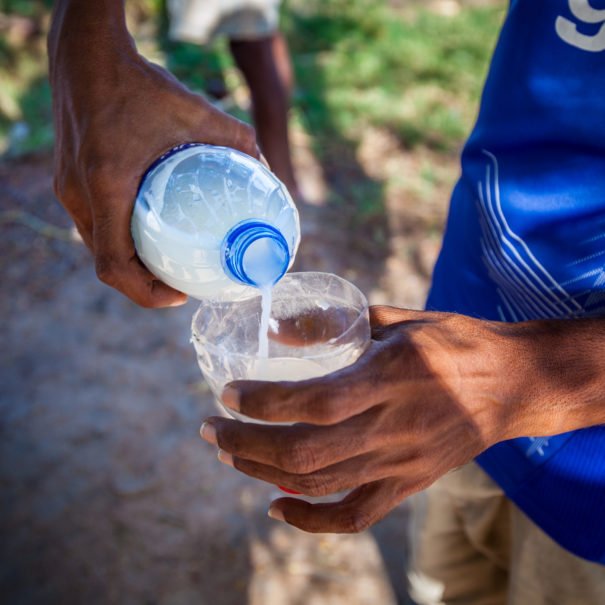
When it Comes to Drinking Palm Moonshine, Timing is Everything

When it Comes to Drinking Palm Moonshine, Timing is Everything
Toddy in Sri Lanka
We find our toddy tavern down a dirt road in Mannar; a one-room structure with a grimy, shadowy interior and an uninspired beige exterior. The only building for miles, it blends in perfectly with its surroundings—parched paddy fields dotted with wandering cows in shades of brown and white.
When the owner, Kumar, hears we are here for fresh toddy, he re-ties his lungi, grabs a jerry can, and heads off into the fields. We follow. The Palmyra palm trees stand in a little clump of green. In Sri Lanka, toddy taken from the coconut tree is the norm, but here in the north, it is the Palmyra palm toddy that is most beloved.
Kumar’s assistant steps up to scale the tree. He places his feet into a closed loop made of cloth, and then bracing himself against the slender trunk, begins his ascent. At the top, he has some clay pots—or muddy—waiting for him.
During the season, he makes this climb every morning and evening to harvest fresh toddy. A few weeks ago, he began by cleaning up the crown of the tree by shearing off old leaves and fruit stalks. He bound the spathe with cloth, and bruised the tender embryo flowers within to help ease the flow of the sap. The end of that bleeding spathe was trimmed and inserted into the clay pot. For the next six months, the plant will pour forth its juices—known locally as kallu—into the muddy.
As we wait, Devan, who brought us here, turns to me and says: “The best way to drink toddy is actually to sit under the Palmyra tree in the morning.” He and his friends will gather under the shade of the arching palm, frying cuttlefish and crab to eat and drinking deep from bottles filled just minutes ago. Sometimes, they will take a dried cuttlefish, stuff it, and marinate it in chili before gently easing into a boiling pan of toddy, where they simmer it until the meat is tender. It is Devan’s idea of a perfect weekend.
Still, we are not doing so badly ourselves. As far as bars go, this one boasts a view. A flock of cranes scatter and take wing over the fields; the sky is a dazzling blue. It is the windy season. The breeze rushes through the shorn stalks of brown paddy, and sets the leaves in the trees rustling. (Imagine a dull roar like the ocean.)
After several minutes, Kumar brings over his haul. It’s in an old mineral-water bottle, which, when sawed in half, also works as a crude cup. We pay him 180 rupees (just over USD$1), and he hands over the bottle.
My first impression is dominated by a sweet, funky stink. On my tongue, the toddy fizzes lightly; cloudy-white, it tastes ripe and yeasty. We put away a whole bottle, and laugh as the edges of the world soften.
This is how Palmyra toddy is meant to be drunk: fresh, under the shadow of the tree itself. If stored, every hour changes its character. A rapid natural fermentation process creates alcohol. Let it ferment for hours, and you have wine; let it ferment for days and you will have a vinegar. Luckily, today, we timed it just right.